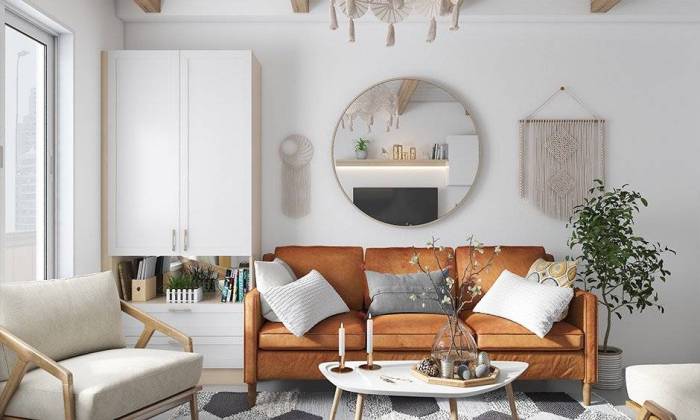Wall Hanging Decor offers a versatile and captivating way to personalize any living space. From intricate macrame to vibrant tapestries and minimalist mirrors, the options are endless, allowing you to express your unique style and create a visually stunning environment. This guide delves into the diverse world of wall hangings, exploring various types, design considerations, creation techniques, styling tips, and maintenance advice to help you transform your home into a reflection of your personality.
We’ll cover everything from choosing the right pieces for your room size and style to mastering the art of gallery wall creation. Learn how to incorporate wall hangings into different interior design themes, ensuring a cohesive and balanced look that enhances your overall aesthetic. Discover the impact of lighting and placement, and uncover simple yet effective methods for cleaning and preserving your cherished wall decor.
Styling and Placement of Wall Hanging Decor

Wall hangings are versatile decorative elements that can significantly impact a room’s ambiance. Their effective styling and placement hinge on understanding how lighting, interior design themes, and the existing space interact. Careful consideration of these factors ensures the wall hanging enhances rather than detracts from the overall aesthetic.
Lighting’s Influence on Wall Hanging Appearance
The interplay of light and shadow dramatically affects how a wall hanging is perceived. Direct, bright light can highlight texture and color vibrancy, making a tapestry or woven piece appear richer. However, harsh lighting can also wash out subtle details or create unwanted glare. Conversely, softer, diffused light can create a more intimate and subdued atmosphere, emphasizing the overall mood rather than specific details.
For example, a delicate watercolor painting might look washed out under bright overhead lighting, but appear more nuanced and atmospheric under the soft glow of a table lamp. Consider the light sources in a room – natural light from windows, overhead fixtures, and lamps – and choose a placement that complements the wall hanging’s material and design. Positioning a piece near a window to catch the natural light during the day, and then adding a strategically placed lamp for evening ambiance, can create a dynamic visual experience.
Incorporating Wall Hangings into Various Interior Design Themes
Wall hangings offer a fantastic opportunity to reinforce or subtly enhance a room’s chosen design theme. In a modern minimalist setting, a simple geometric tapestry in neutral tones would be appropriate, avoiding excessive patterns or embellishments. Traditional interiors, conversely, could benefit from richly colored tapestries with intricate details, perhaps incorporating historical motifs or patterns. A farmhouse aesthetic might call for rustic, natural materials like woven textiles or repurposed wood signs, adding a touch of warmth and character.
The key is selecting pieces that align with the overall color palette, textures, and style of the existing décor. For instance, a vibrant, abstract painting would clash with the subdued tones of a traditional English style room, whereas a framed botanical print would seamlessly blend in.
Choosing the Correct Size and Placement of Wall Hangings
Determining the appropriate size and placement of wall hangings is crucial for achieving visual balance and harmony. A piece that is too small can get lost in a large room, while one that is too large can overwhelm the space. A general rule of thumb is to consider the scale of the furniture and architectural features. In a living room with a large sofa, a sizable tapestry or artwork might be ideal, creating a focal point.
However, in a smaller room with delicate furniture, a smaller, more understated piece might be a better choice. Placement is equally important. Avoid hanging pieces too high or too low; aim for a comfortable viewing height, typically around eye level. Consider the existing architectural features, such as fireplaces or built-in shelving, and use the wall hanging to either complement or contrast these elements.
For example, a horizontally oriented piece can visually widen a narrow wall, while a vertically oriented piece can draw the eye upwards, making a room feel taller. The space around the hanging should also be considered to prevent a cluttered appearance.
Maintaining Wall Hanging Decor

Preserving the beauty and longevity of your wall hangings requires understanding the specific needs of their materials. Proper care prevents damage from environmental factors and ensures your cherished pieces remain vibrant and intact for years to come. This section details cleaning, care, and repair techniques for various materials commonly used in wall décor.
Cleaning and Caring for Different Materials
Different materials require different cleaning approaches. Fabric wall hangings, for instance, necessitate gentle handling to avoid damage. Wood and metal pieces, while more durable, still need appropriate cleaning methods to prevent deterioration.
- Fabric: Regular dusting with a soft brush or vacuum cleaner with a brush attachment is crucial. For spot cleaning, use a mild detergent solution and blot gently; avoid rubbing. Air dry completely before rehanging. For delicate fabrics, consider professional cleaning.
- Wood: Dust regularly with a soft cloth. For more thorough cleaning, use a slightly damp (not wet) cloth and wood polish specifically designed for the type of wood. Avoid harsh chemicals or abrasive cleaners.
- Metal: Metal wall hangings can be cleaned with a soft cloth and mild soapy water. For tarnished pieces, use a metal polish appropriate for the type of metal. Always rinse thoroughly and dry completely to prevent rust or corrosion.
Preventing Damage from Environmental Factors
Sunlight, moisture, and dust are common culprits in wall hanging deterioration. Understanding how these elements affect different materials is key to preserving your décor.
- Sunlight: Prolonged exposure to direct sunlight can fade colors and damage materials. Hang your wall hangings in locations with indirect sunlight or use UV-filtering curtains or blinds to protect them.
- Moisture: Excessive moisture can lead to mold, mildew, and warping, especially in fabric and wood pieces. Ensure adequate ventilation in the room and avoid hanging wall décor in damp areas. In case of accidental spills, blot immediately and allow the piece to dry thoroughly.
- Dust: Regular dusting prevents the accumulation of dust, which can dull the appearance of your wall hangings and potentially damage delicate materials. Regular cleaning, as described above, is crucial.
Repairing Common Damage, Wall Hanging Decor
Minor damage, such as tears or scratches, can often be repaired at home. However, for significant damage, professional restoration may be necessary.
- Tears in Fabric: Small tears in fabric wall hangings can be mended with fabric glue or carefully stitched using a needle and thread that matches the fabric color. For larger tears, professional repair is recommended.
- Scratches on Wood: Minor scratches on wood can be concealed using wood filler or touched up with wood stain. For deeper scratches, professional refinishing may be needed.
- Dents in Metal: Minor dents in metal can sometimes be gently tapped out using a rubber mallet. For significant damage, professional repair may be required.
Ultimately, mastering the art of wall hanging decor is about expressing your individuality and creating a space that truly reflects you. By understanding the various types of wall hangings, design principles, and maintenance techniques, you can confidently transform your walls into captivating displays of artistry and personal style. Experiment with different textures, colors, and placement strategies to achieve a look that’s both aesthetically pleasing and deeply personal.
Let your walls tell your story!